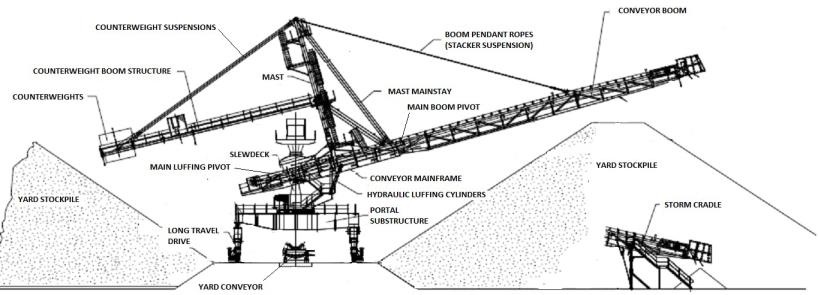Background
Rail-mounted stackers typically consist of a pin-jointed boom and counterweight assembly that relies on suspension ropes (pendants) and rigid stays for structural stability. The stacker’s position ismaintained by hydraulic luffing cylinders, a slewing drive system and long-travel drives.

The conveyor and counterweight booms are supported at a main luffing pivot on the slewdeck. This allows the entire assembly to luff under the action of two hydraulic luffing cylinders, as well as slew under the action of a slewing drive system.
Counterweights can be configured such that, if the hydraulic luffing cylinders fail to hold the stacker at the required luffing angle, the stacker will slowly luff up and away from the stockpile under the action of the counterweights.
Recently, two potentially serious incidents during shutdowns have raised concerns about the operation and isolation of rail-mounted stackers. On both occasions, workers located on the machine and in the vicinity had to evacuate when isolation procedures failed.
On one occasion, there was an unexpected, uncontrolled movement of the counterweight boom and conveyor boom structures while both boom pendant ropes were being replaced. The counterweight boom crept down by about 15° of arc over a period of nine minutes. Although parked on a supporting tower, without the boom pendant ropes to stabilise it, the conveyor boom pivoted at the main boom pivot as the counterweight boom dropped.
On another occasion, there was an unexpected, uncontrolled movement of the conveyor boom while workers were replacing belt rollers on the boom conveyor. The conveyor boom luffed upwards from a near-horizontal position to its fully raised position under the action of the counterweights. On its way up, the conveyor boom struck the sheave block of a mobile crane.
Summary of hazard
As well as general machinery hazards, rail-mounted stackers have unique hazards associated with their stability. There is the potential for:
- uncontrolled luffing movement of the boom assemblies (conveyor and counterweight) if the hydraulic luffing system fails to hold the load
- catastrophic structural collapse if suspension ropes, fixed stays or pin joints either fail or are removed
- during maintenance activity
- out of sequence without appropriate controls
- overturning if the machine is not correctly balanced with counterweights in accordance with the designer’s intent
- overturning under abnormal loading conditions
- derailment from long-travel rails.
For people on or near these machines, there is the potential to be struck or crushed by moving or falling parts. In the event of a catastrophic structural failure, there is often little warning and usually insufficient time to escape the vicinity. There may also be further effects if the uncontrolled movement or failure interacts with other plant or structures.
Contributory factors
- The isolation procedures need to recognise and control all sources of hazardous energy, including gravitational potential energy. For example, the consequences of isolation failure may increase when inaccurate balance weight information is used.
Note: Although not identified as a significant contributory factor for these incidents, the isolation procedures had not been based on accurate balance weight information (e.g. derived from commissioning records or current hydraulic luffing trend information for the stackers). - Solely relying on a single hydraulic system to resist luffing moment from an otherwise unrestrained load or loads is not a reliable method for isolating the machine from uncontrolled luffing movement.
- The hydraulic relief valves of the luffing system involved in both incidents cannot be tested in situ, making it impossible to confirm that the set-points (critical to the luffing functions of the machine) are correct and have not been tampered with.
Note: It was reported for one of the incidents that locking tabs had been removed from the relief valves and they appeared to have been adjusted. This may have allowed hydraulic oil from the luffing cylinders to relieve to the reservoir, preventing them from holding the load.

